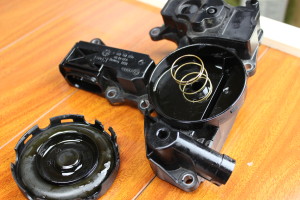How The VW 2.0t TSI PCV Valve Fails~ Video
 Happy Tuesday everyone. Today we are back talking about failed VW parts. This time we are looking at the failure of the 2.0t TSI Positive Crankcase Vent Valve, or PCV. This is a part that can cause some crazy things to happen. PCV used to be a simple little valve that was replaced at maintenance intervals. Now it is a complex assembly.
Happy Tuesday everyone. Today we are back talking about failed VW parts. This time we are looking at the failure of the 2.0t TSI Positive Crankcase Vent Valve, or PCV. This is a part that can cause some crazy things to happen. PCV used to be a simple little valve that was replaced at maintenance intervals. Now it is a complex assembly.
Sponsor Of The Day
Today’s show is sponsored by Deutsche Auto Parts. They are the VW and Audi parts experts. They have great prices and awesome service. Plus they work really hard on a ton of VW DIY videos. Paul and the boys at DAP are awesome. Check them out! Here are links to the PCV as well as a “how to” on replacing it.
Join me today as we look at:
- What the 2.0t PCV does, and needs to do
- How the 2.0t PCV can fail
- Signs on 2.0t PCV failure
- Diagnosing 2.0t PCV failure
- Common miles and age of 2.0t PCV failure
- DIY or No DIY
- Related part to replace
- and more
Having trouble watching? See “How The VW 2.0t TSI PCV Valve Fails~ Video” on YouTube.
As always, your questions and comments are welcome. Please post them below. If you would like to suggest a part of a show like this, email me Charles(at)HumbleMechanic(dot)com. Also thanks to VW for hooking up some sweat VW Driver Gear. And Thanks again to Deutsche Auto Parts for being such a great sponsor.

Don’t forget to follow me at:












Hey Charles! Great video! I heard you mention you were replacing a lot of these oil separators under powertrain warranty. I was just wondering if you had any idea how you were getting these covered under powertrain? I work at a dealer and, we’ve been told by Volkswagen that the oil separators aren’t powertrain items as the service number and labor op they want us to use to code them isn’t listed under powertrain.
Not sure I will check with my warranty clerk.
Hey charles thanks for the video, i just recently bought a 2009 gli tsi 2.0 and on the way home the pcv hose blew off on the intake end and started to cause alot of problems, there are no leaks but alot of rough idle, surging and miss fires. What do you think caused this and how can i fix it
Thanks for the video! Unfortunately it may be to late for me as I already had a rms leak that needed to be replaced out of warranty. I was not told what caused the leak. Is there any way I can test the pcv valve without removing it? I have had misfires in the past when Temps are low.
Air leakage sound vw gti 2009 close shows air leakage…check engine light on
Air leakage sound vw gti 2009 close shows air leakage…check engine light on
I removed my Pcv and found no holes in the diaphragm, however, I’m on my 4th dv and can only attribute it to the bit of oil coming down the intake. Upon removing the pcv. I can easily blow through the pressure side, but not from the intake to pressure side. Does this mean it’s gone?
I’m hearing a loud squealing noise when my 09 vw cc 2.0t is in idle. My dealer just replaced the turbocharger and water pump. Is this the result of a bad pcv valve if so, how should I go about testing if it is. It is under warranty
Great video. Thank you for the effort. You mentioned an older video with the FSI motor. I have the BPY engine and would be delighted watch the video as it seems a failed PCV is what I’m looking at.
Thanks Randall,
I don’t think that I did a video on that PCV system. The next time I get a failed one, I will save it for a video
Did you ever do this? We’re looking at the second one in two years or less. Tiring and expensive.
Does the vent hole on the diaphragm valve cover normally spit out air?
I’ve covered it to try and pinpoint a vacuum leak, idle RPM drops slightly and then when I release it it almost stalls the engine.
No, it does not. I guess the hole is there for exactly this – diagnostic purposes – so that you don’t have to take the oily mess apart before ordering a new diaphragm. Once the diaphragm is shot, you have a vacuum leak at that hole. I don’t think the diaphragm protects against backfire, the check valve does that (that’s how I understand it, at least). Once the diaphragm sticks to the outlet too much, due to sticky oily gunk, the differential pressure between the atmosphere and the intake tears a hole in the diaphragm, so that it becomes leaky and doesn’t react to the vacuum. You get less crankcase ventilation and some more unmeasured air this way but at least the ventilation doesn’t get blocked and/or the engine doesn’t suck in rubber pieces and too much oil. This might be the theory, though exceptional circumstances may occur, I also might have understood it the wrong way, although the sure thing is that the hole is normally not leaking, as you don’t normally want unfiltered air through the hole and intake.
*through the oil and intake.
Hey Charles,
I have an Audi A3 qtro with ccta and 178000 km on it.
My car eats oil like nobody’s business, and keeps blowing pcvs …. I’ve had it for a year and a half and I’m on my third or fourth ….
Do you think the pcv failing is a result of a faulty check valve thats in the oil pan? …. I’ve read all the threads on forums and also have read up on the tsi gen 1-2 in a self study PDF made by vw.
I believe it could be the oil pan check valve because it is part of the crankcase vent system.
Your help is appreciated.
Thanks,
MB
Start with the cheapest ones you know you have never replaced, then check the ones you have already replaced (whether done correctly), diagnose, do the more bothersome, if necessary, diag, do the PITAs.
1. oil cap/oil cap sealing ring (both the cap itself and the one between the valve cover and the plastic oil-filling funnel under the cap if your car has one)
2. dipstick o-ring
3. gaskets of intake sensors, meters
4. gaskets between the filter and throttle, turbo (not unmetered but still dirty air is no good)
5. pcv ducts, grommets, the respective sealing, any check valve (might be part of a hose)
6. Valve cover gasket! (remember, the pcv was shot before, and the new one shortly after)
7. injector o-rings
8. intake manifold gasket
(9. if your engine was NA (ie not TSI), the power brake hose, fittings, check valve but it’s not the case with turbos, just might help someone else)
Having just replaced the PVC valve on a 2013 TSI and still getting a P2177 code I started looking for vacuum leaks and would like to know if it is normal for a good PCV valve to expel a small amount of air through the vent hole? The intake manifold has been replaced in the past (twice) and appears not to be the issue. Any other ideas?
Many Thanks, MA
Start with the cheapest ones you know you have never replaced, then check the ones you have already replaced (whether done correctly), diagnose, do the more bothersome, if necessary, diag, do the PITAs.
1. oil cap/oil cap sealing ring (both the cap itself and the one between the valve cover and the plastic oil-filling funnel under the cap if your car has one)
2. dipstick o-ring
3. gaskets of intake sensors, meters
4. gaskets between the filter and throttle, turbo (not unmetered but still dirty air is no good)
5. pcv ducts, grommets, the respective sealing, any check valve (might be part of a hose)
6. Valve cover gasket! (remember, the pcv was shot before, and the new one shortly after)
7. injector o-rings
8. intake manifold gasket
(9. if your engine was NA (ie not TSI), the power brake hose, fittings, check valve but it’s not the case with turbos, just might help someone else)
Hi, i came from Québec, i have a 2013 GTI 2.0l turbo, I just want to known if the PCV can be the source of a huge oil consumption because i have a lot of oil at the enter of the turbo near of the tube that came from the PCV valve thanks have a nice day
Why would it not be?
Also check out my other replies above.
Hi,
We have a 2015 VW Passat TSi wolfsburg edition. It’s a 1.8l and this video title is about a 2.0. We just got the car given to us at the beginning of October. After a month I took it to get the oil changed. Since then about every two weeks the oil light comes on and it’s down to the bottom of the hash mark. The first time I took it back my oil tech said it was because his service guy didn’t put drain plug back in correctly. Now, this time, it’s low again, but now visible leaks by drain plug, oil filter, or drips in my driveway. We are using full syn oil. He says it might be burning internally. I googled and PCV issue came up and you mentioned in this video. I will changed this out but wanted to see if there was a difference between my 1.8 and the 2.0 you the video is about.
Hi
Thanks for all you do!
2009 GTI w/TSI
My names Dave
Trying to wrap my head around this one… P0171 code, slightly rough idle.
Thought PCV, replaced valve with a Vaico kit PN V10-3881.now it’s real bad throwing miss fire codes and stalling. Unplug hose on intake side, and plug intake and it smoothes right out. Swap the old one back in and back to normal idle.
So now I’m figuring the old PCV is covering up a gross leak somewhere else, but where? No oil at RMS, a bit of seepage around valve cover, but can’t imagine it’s enough to cause the degree of roughness I’m seeing.
Any idea appreciated!!
Dave